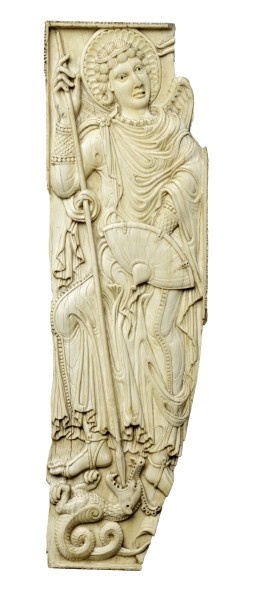
Find the perfect fit with Amazon Prime. Try Before You Buy.
Archangel Michael Killing a Dragon
Carolingian Ivory Panel, c.800AD. Grassi Museum, Leipzig, 1953.50

A larger print by Goldschmidt of 'Archangel Michael Killing a Dragon'. Carolingian Ivory Panel, 9th century. Plate VI-11a.
|
Description Die kleine, geschnitzte Elfenbeintafel zeigt den drachentötenden Erzengel Michael. Gott selbst – seine Hand ist am rechten oberen Rand zu erkennen – hat ihn damit beauftragt. Michael, der kämpferischste der Erzengel, galt schon seit dem frühen Christentum als Schutzgeist und Beistand im Kampf gegen Ungläubige. Ein Gedanke, der in der Entstehungszeit des Reliefs, um 800, angesichts der Eroberung Spaniens durch die Mauren großes Gewicht besaß. Einst war die Tafel wohl Mittelstück eines prächtigen Buchdeckels. Eine Inschrift auf der Rückseite verrät jedoch, dass sie – noch nicht reliefverziert – ursprünglich Teil eines klappbaren Schreibtäfelchens war, das der römische Konsul Flavius Messius Phoebus Severus wahrscheinlich zu seinem Amtsantritt im Jahre 470 herstellen ließ. Herkunft: karolingisch Aus der ehemaligen Leipziger Ratsbibliothek, 1953 überwiesen. Material/Technique Elfenbein, geschnitzt; Glaspaste Measurements Höhe 33,6 cm, Breite 10 cm |
Description The small, carved ivory tablet shows the dragon-slaying Archangel Michael. God himself - his hand can be seen on the upper right edge - has commissioned him to do this. Michael, the most combative of the archangels, has been considered a protective spirit and supporter in the fight against unbelievers since early Christianity. A thought that was very important in the time when the relief was created, around 800, when Spain was conquered by the Moors. The table was once the centerpiece of a magnificent book cover. However, an inscription on the reverse reveals that it was originally part of a foldable writing tablet - not yet decorated in relief - that the Roman consul Flavius Messius Phoebus Severus probably had made when he took office in 470. Origin: Carolingian Transferred from the former Leipzig Council Library, 1953. Material / Technique Ivory, carved; Glass paste Measurements Height 33.6 cm, width 10 cm |
